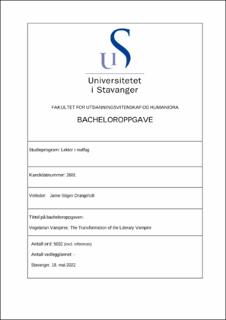| dc.contributor.advisor | Drangsholt, Janne Stigen | |
| dc.contributor.author | Østebø, Marlene Seljeskog | |
| dc.date.accessioned | 2022-07-01T15:51:31Z | |
| dc.date.available | 2022-07-01T15:51:31Z | |
| dc.date.issued | 2022 | |
| dc.identifier | no.uis:inspera:110340825:37362312 | |
| dc.identifier.uri | https://hdl.handle.net/11250/3002106 | |
| dc.description.abstract | Denne bacheloroppgaven tar utgangspunkt i to ulike vampyrnarrativer fra to forskjellige århundrer; John Polidoris "The Vampyre" fra 1818 og Stephenie Meyers "Twilight" fra 2005. Oppgaven tar opp vampyrkarakterens forandring de siste årene, fra monster til romantisk interesse, med fokus på etikk og moral som typisk vampyrtrekk. Videre vil oppgaven diskutere vampyrens rolle i, og hvordan forandringene i vampyrenes beskrivelser kan knyttes til den. | |
| dc.description.abstract | Although the contemporary, modern vampires are drawn on the conventions and images of the past vampires, they are far more sympathetic and self-aware than those of the 19th century. One may say that the biggest change in vampire literature the last 200 years is that the gothic vampire was a monster, not only because of its blood drinking or murdering, but also due to its treatment of human beings and wilful ignorance of societal rules. This opens a discussion regarding what a monster really is, and if vampires automatically are monsters.
Through a close reading of John Polidori's "The Vampyre" and Stephenie Meyer's "Twilight", this thesis aims to demonstrate how the vampire character is connected to ethics and morals, as well discuss how this is illustrated by the vampire figure's transformation. | |
| dc.language | eng | |
| dc.publisher | uis | |
| dc.title | Vegetarianske Vampyrer - Den litterære vampyrens utvikling | |
| dc.type | Bachelor thesis | |
